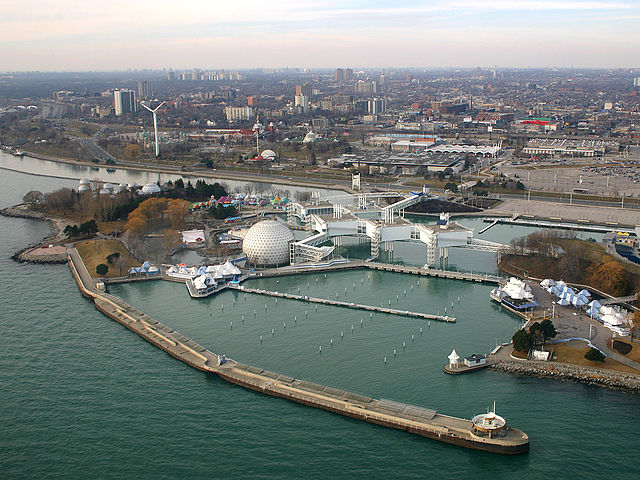
Toronto waterfront. Image: Wikipedia
By Eric Freedman
Mercury levels are down in sport fish species along the Toronto waterfront but PCB levels remain above levels considered safe for human consumption, according to a new study by scientists at the Ontario Ministry of the Environment and Climate Change and the University of Toronto,
“In contrast to mercury, total PCB concentrations in fish from the Toronto waterfront area remain a concern and will likely be so for more than a decade,” the researchers said in an article recently published in the ”Journal of Great Lakes Research.”
Mercury, PCBs and dioxins from industry, runoff and other sources are responsible for most fish consumption advisories for Lake Ontario.
In 1987, the International Joint Commission designated an Area of Concern (AOC) with 26 miles (42 kilometers) of Lake Ontario shoreline, including the Toronto waterfront.
A remediation plan for the AOC and six adjacent watersheds is in place to address pollution, with the goal of ending — delisting — the AOC by 2020. Measures include reducing contaminants flowing into the watershed from stormwater and better management of spills, according to the study.
There are fish consumption advisories for a number of sport fish species found in the Toronto waterfront area: brown trout, northern poke, rainbow trout, common carp, brown bullhead, smelt, tallow perch and white sucker.
The study is part of long-running research that is used to update fish consumption advisories every two years, said co-author Margaret Neff, a sport fish and biomonitoring scientist in the ministry’s Environmental Monitoring and Reporting Branch. The next updates are scheduled for 2017.
The research team found significant drops in mercury concentrations since the 1970s for at least some sizes of brown bullhead, northern pike, white sucker and tallow perch, and non-significant trends or lower concentrations in at least some sizes of common carp and rainbow smelt.
As for PCB concentrations, there were significant decreases for at least some sizes of northern pike, brown trout and white sucker.
But not all the findings were encouraging.
Total PCB concentrations remain higher than the health advisory benchmark for some sizes of brown trout and white sucker, the study said. As for prospects for bringing PCB levels down to safe levels in the near future, the study sounded pessimistic:
“PCB levels within multiple fish species remain a concern within the Toronto waterfront,” they said. “Half-life calculations suggest that it may take eight to 26 years for total PCB concentration in fish to decrease below the consumption advisory level.”
The study cited several factors contributing to past and current PCB levels, including the heavy use of construction materials containing PCBs in the 1950s and 1960s and PCB-contaminated sediment from dredging in the region.
“Urbanization leads to increased habitat loss and degradation, an increase in impervious surfaces and an increase in the quantity of stormwater runoff,” it said. “Despite the city of Toronto’s improvements in wastewater infrastructure, combine sewer overflows and stormwater overflows continue to be sources of contamination into the waterfront,
PCBs also come in from tributaries, it said, for example the Don River, which provides 90 percent of land-based flow into the waterfront and “has been identified as being a dominant source of contaminant loading.”
Chemistry also plays an important role because of the long half-life of PCBs — from eight to 14 years in brown trout, northern pike, tallow perch and white sucker in the waterfront area, it said.
Neff said contaminant monitoring work is continuing.
“We will collect fish ourselves and with other partners with varying frequency,” she said, with the Toronto waterfront being tested more often than some other locations in Ontario. The results are used for consumption advisories to inform other agencies on the situation.
